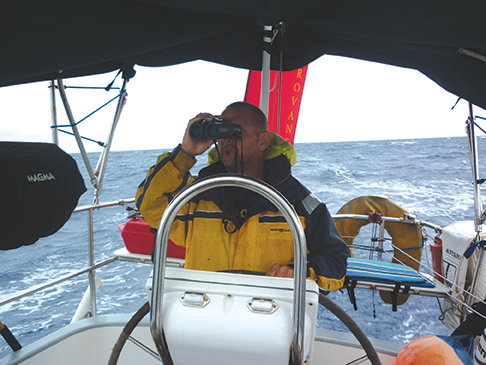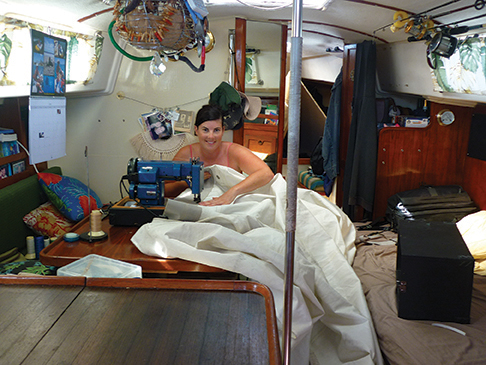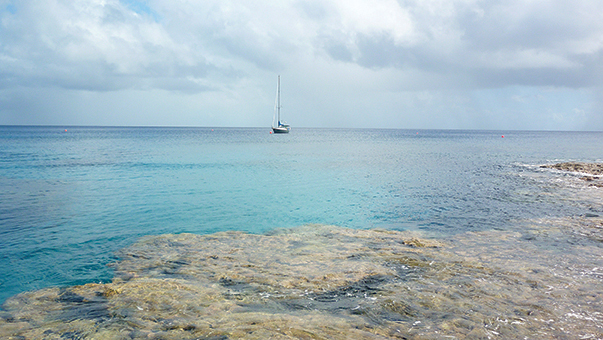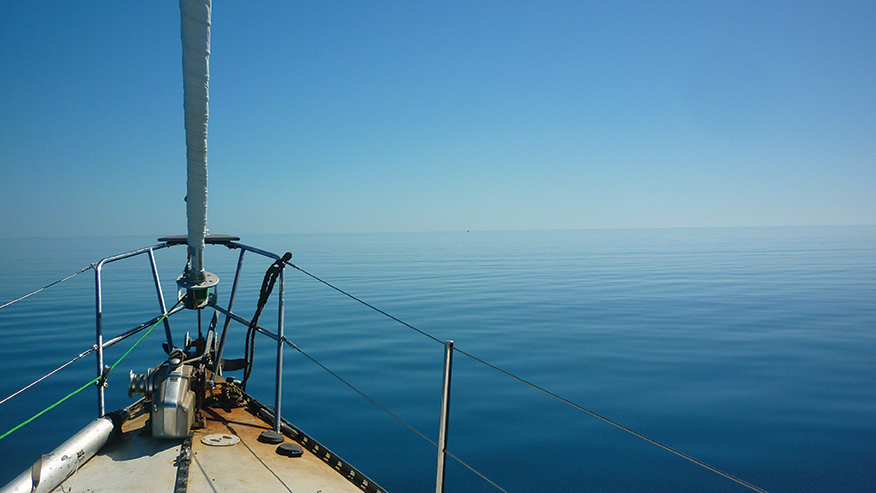An eventful passage between French Polynesia and Niue (published December 2014)
It was going to be just another downwind leg on the long voyage that was taking us slowly across the South Pacific. Our passage, from French Polynesia to the small island nation of Niue, would take us back into the area of ocean where the South Pacific Convergence Zone (SPCZ) dances across the globe.
We had passed through this expanse before on our way back from the Cook Islands a few months ago. It turned our five day windward passage into an eight day epic battle of will, churning up the seas as much as it did my stomach. We were hoping the two dominate weather systems that often collide here, like a meteorological roller derby, would do as the forecast predicted and call a truce. We were about to sail back into the “Dangerous Middle”.
We had spent the cyclone season in French Polynesia and were reticent to leave Huahine, our new favorite anchorage, but knew we wanted to get moving before the “Puddle Jumpers” swarmed the anchorages. When we stuck our bow out past the reef we found light winds and a confused sea. Our rhumb line was dead down wind and impossible to stay on so we jibed back and forth for the afternoon hoping that once we rounded Raiatea and got away from the scattering of surrounding islands the seas would lay down.
FUELED AGAIN
I went below for a few hours rest and noticed that the air was laced with the oily scent of diesel. Checking the bilge I found a slick of fuel, a shiny rainbow that undulated as the boat rocked. It wasn’t very much, but my head swam and my stomach lurched; nothing makes me feel so immediately ill at sea like the thick odor of fuel. I sprayed around some degreaser, poured in a few liters of fresh water and closed the access hatch on the floor, content to let the motion of the boat distribute the cleanser around. Popping outside into the cockpit for a few breaths of fresh air, I hoped to settle my stomach and clear my foggy head. I then scrubbed and pumped the bilge, but we still spent the night blanketed in fumes.
Sitting watch on the second afternoon I noticed a waft of diesel again. Down below the cabin was thick with its heavy perfume. I tried breathing through my mouth in an effort not to smell diesel but ended up tasting it instead. The clean bilge was again sullied with fuel. I checked the fuel hose, the main tank and the engine compartment. No leak. I kept searching, much to the chagrin of my stomach and Steve, who was trying to get some rest. I couldn’t stand another night huffing fumes.
At 1730, after emptying the contents of the lazarette into the cockpit, we found the culprit; the breather on an old jerry can was leaking and the lazarette emptied into the bilge. Although we had barely lost a half a liter of diesel everything it came into contact with was covered in a slimy slick, like a toxic snail’s trail. While the boat lulled in the still choppy seas I held gas bottles, dive tanks and paint cans from rolling around the cockpit and Steve scrubbed the lazarette, then the bilge and then himself. It was dark before we sat down to a hot meal of chicken curry, both tired and grumpy from the effort.
For the next two days the boat rolled and pitched in the sloppy seas and progressively lighter winds. The skies were a dull grey and often seemed low enough to touch. Neither the solar panels nor the wind generator were able to keep up with the constant demand of the instruments running day and night. Our batteries were struggling. When the navigation lights were turned on at dusk the fridge and freezer had to be turned off. We will always sacrifice crisp, green vegetables in order to be seen at night.
We tried running the engine to charge the batteries but we hadn’t topped up the diesel tank before departure and now, with the boat rocking back and forth, we were occasionally sucking air instead of fuel. Steve wasn’t keen on trying to balance a full jerry can outside the railing while fueling and was worried about contaminating the tank with seawater. He rigged up an ingenious pump using the fuel hose from the dinghy tank, manually compressing the bulb to move the fuel. Within minutes we had an extra five gallons in the tank, enough to let us run the engine without picking up air.
GUNNEL TO GUNNEL, THAT’S HOW WE ROLL!
We were still sailing downwind but now the breeze was too light to carry both the main and the headsail, so we ran with just the gennaker, reefed and poled out to keep it from collapsing. We were making barely 100 miles a day. Without enough wind to keep us heeled we wallowed in the swell, which had yet to lie down. The weight of the spinnaker pole added to the pendulum effect but without it the headsail popped and jerked, shaking the rigging and straining our nerves. Sitting in the cockpit I watched the little black bead in the inclinometer roll from 25 degrees port to 25 degrees starboard. It was beginning to feel like we were the proverbial cork in the bathtub.
By the fourth day neither of us had gotten more than two hours of sleep at one time. I resigned to sleeping on the floor, splayed out like a starfish on the cabin sole, the only place that I didn’t feel like I was falling. When I finally did fall asleep it was never long before I was jarred awake by a snap of the headsail and the twang of the rigging as the boat fell over the uneven swell. Soon, it was a boat full of long days and short tempers.
EVERYONE, BE CALMED
After a week at sea the wind died completely and we had three days of unbelievable stillness. The horizon was a relentless flat line, the sky cloudless and the ocean a sheet of glass. The sluggish progression of numbers on the GPS was the only indication that we were moving, otherwise it seemed like we were in complete suspension; adrift and alone in every way possible.
We took advantage of the calm and caught up on sleep, both of us bleary eyed and run ragged by the last week of the uneven and constant movement of the boat. I read a book a day including Charles Dickens and Dumas; writers that demand attention I am not usually able to give underway. At night we enjoyed spectacular meteor showers, the sky filling with streamers of light.
But tensions grew. We’d gorged ourselves of sleep and now had our fill of being becalmed. We were on passage after all, we were meant to be moving. After a particularly quiet day, when only a handful of words were exchanged, and not all of them polite, I made a bowl of popcorn and surprised Steve in the cockpit. We sat licking our fingers and sharing a beer, suddenly content to stop straining against our uncontrollable situation and enjoy the afternoon together in our own private world. We called it our romantic getaway.
TOO MUCH OF A GOOD THING
By the tenth day the winds filled in. After days and days of holiday skies, clouds now reached across the sky; mackerel patterns, lines and wisps. Wind clouds. By that night we were able to take down the pole and carry the headsail completely unfurled. The seas picked up again but since we had enough wind to sail it was comfortable. We finally were making some miles.
Dawn of the following day saw us running with steady 25 knot winds that were pushing up three-meter seas. By evening we had winds over 30 knots and gusts of 40, and the seas ran in angry four-meter swells. It was wet and sloppy with the occasional wave sneaking into the cockpit. When we buried the rail it dug up great quantities of water and deposited it in the cockpit, often in my lap.
Kate’s gallop was starting to feel a little out of control so we pulled in a some headsail to rein her in. While Steve was on watch one particularly large wave pushed over the rail, filling the cockpit so that he was almost knee deep in water. It started seeping through the cracks in the storm boards and streaming into the cabin before the cockpit scuppers had time to release it back into the ocean.

Niue was just a speck on the vast emptiness of our chartplotter when it finally came into view. Sure that we would be able to make landfall by dark we started gambling with our watch hours, taking longer turns in the cockpit and finding less time to rest. But just when it was looking like we would make landfall by dark our instruments went black. We suddenly had no GPS, no chartplotter, no wind instruments and we suspected when we got closer to land we’d have no depth sounder either. We were running blindly towards an unfamiliar harbor and to make the situation just a bit more fun, we were doing it at dusk with almost no sleep between us.
We figured it was water ingress from some of the big waves that had been turning the cockpit into a swimming pool, but neither of us were up to troubleshooting electrical problems in cramped compartments while being thrown around by the weather. I booted up the backup navigation software on the laptop but the cockpit was too wet to take the laptop out to where the helmsman could see it, and it wasn’t a very detailed chart anyway. I searched through our backup paper charts but found nothing more recent or smaller scale. I skimmed the brief cruising guides we had and found more bad news; tales of unmarked reefs, notorious wrecks and unlit FADS.
We sailed the length of the west side of the island but the lead lights indicating the harbor was nowhere to be seen in the darkness. We were in the lee of the island and now protected from the swell but still being buffeted by 25 knot winds. The starless sky was low with clouds and so were our moods. Exhausted and sailing virtually blind we knew it would be a fool’s mission to try and find the mooring field before morning light. We decided to heave-to, a tactic we almost never employ.
For the first time since the beginning of the trip we raised the main, tucked in the second reef and then backed the already reduced headsail hoping to find a comfortable balance for the night. Steve sat the first watch and I was ordered below to finally get some sleep. He’d been standing at the wheel for most of the day and night but I could tell it was not up for debate.
LONGEST. DAY. EVER.
At 0200 I relieved my weary captain. As I stood in the cockpit with a hot cup of tea I monitored the slow progress of the boat by the one instrument that was still working, the speed log. The wind had eased slightly and we were making less than a knot, but I didn’t want to stray too far from the island and the protection it was providing from the open ocean swell. After a few hours I jibed to head back towards Alofi Harbor.

As the boat came around there was a soft ripping sound, like over-used Velcro being pulled apart, and then light flapping noises above my head. Shinning my flashlight towards the mast I saw a jagged gash of black where white sail cloth should have been. The mainsail was in a crumpled pile on the boom, only the thin leech line connecting it to the headboard that hung limply from the halyard. It had ripped from luff to leech clean through the third reef points leaving it completely useless. As I lowered the scrap of sail and tied the whole mess to the boom the rain started, saturating my rain gear in a matter of minutes. Soaked and defeated I bounced from foot to foot to keep warm, hoping that dawn would shed some positive light on our predicament.
The dull morning light revealed that we were directly in front of the town of Alofi. A scattering of faded orange buoys marked the mooring field and an imposing concrete dock jutted out into the open roadstead harbor. We just had to sail three miles directly to windward in what was again 30 knots of wind without the mainsail to get there.
Two hours later, after more tacks than I cared to count, we furled in the headsail, tied Kate to a mooring ball and notified radio Niue of our arrival. They welcomed us but advised that if the wind changed direction we were required to abandon the harbor, they’d lost one too many boats on the sharp and jagged lee shore in a westerly. With no chartplotter, no wind instruments, no depth sounder and now no mainsail we had a lot of work to do to get the boat seaworthy again.
 I slipped a large splash of rum into our morning mugs of tea, something we both agreed I should have done sooner. We reminisced about the passage over breakfast and it was hard to believe it had taken us 12 days to sail the 1,100 miles from Huahine. Although we were swinging safely on a mooring at our destination of Niue, it seemed like we still had a long way to go.
I slipped a large splash of rum into our morning mugs of tea, something we both agreed I should have done sooner. We reminisced about the passage over breakfast and it was hard to believe it had taken us 12 days to sail the 1,100 miles from Huahine. Although we were swinging safely on a mooring at our destination of Niue, it seemed like we still had a long way to go.
Heather Francis is originally from Nova Scotia, Canada and has been sailing with her partner, Steven Hertik, on board their Newport 41 Kate since 2008. They have spent the last three years in the South Pacific. To follow their adventures log onto www.yachtkate.com.

















